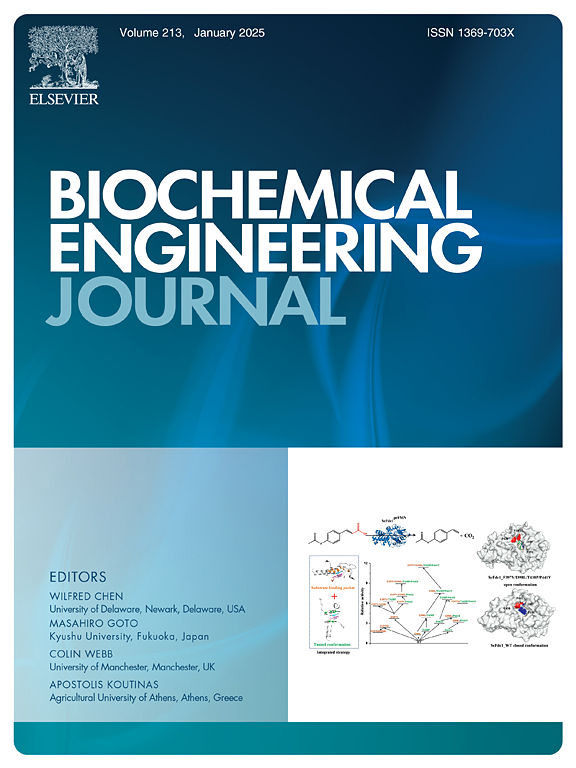Bark as the optimal filler for the start-up phase of deodorizing bio-drip filters under actual farm conditions
IF 3.7
3区 生物学
Q2 BIOTECHNOLOGY & APPLIED MICROBIOLOGY
引用次数: 0
Abstract
Biological trickling filter (BTF) is a commonly used deodorization technique in pig farms. However, filler selection under actual operational conditions is often limited, as most studies still focus on laboratory-scale experiments. Here, we compared the effects of five fillers (bark, straw, moving bed biofilm reactor packing (MBBR), grit, and polyester fiber) on the deodorization performance in the start-up phase of BTF in actual farming conditions. Bark has the best deodorizing properties. The deodorisation efficiency followed the order: bark > straw > MBBR > grit > polyester fiber. The removal rate of volatile organic compounds reaches 40–65 %, 100 % removal of malodor can be realized. In terms of ammonia removal, bark (90 %) and straw (91 %) showed significant advantages; H2S was completely removed except for polyester fibers. The particulate removal efficiency of MBBR was significantly lower than that of other fillers. Pressure drop stability followed the order: bark (40 Pa/d) < grit = polyester fiber (50 Pa/d) < MBBR (60 Pa/d) < straw (80 Pa/d). In addition, pressure drop was positively correlated with odor and VOCs removal. SEM characterization and biomass analysis revealed that the biomass of straw filler (230 CFU/mL) was significantly higher than that of other fillers. However, the correlation with deodorisation performance was weak. Our results provides a cost-effective and efficient solution for odor control in large-scale pig farms.
在实际农场条件下,树皮作为除臭生物滴滤启动阶段的最佳填料
生物滴滤(BTF)是养猪场常用的除臭技术。然而,在实际操作条件下填料的选择往往是有限的,因为大多数研究仍然集中在实验室规模的实验。在实际养殖条件下,我们比较了5种填料(树皮、稻草、移动床生物膜反应器填料(MBBR)、砂砾和聚酯纤维)对BTF启动阶段脱臭性能的影响。树皮有最好的除臭性能。脱臭效率顺序为:树皮>; 稻草>; MBBR >; 砂砾>; 聚酯纤维。挥发性有机物去除率达40-65 %,恶臭去除率达100 %。在脱氨方面,树皮(90 %)和秸秆(91 %)表现出显著的优势;除聚酯纤维外,H2S被完全去除。MBBR的颗粒去除效率明显低于其他填料。压降稳定性排序为:树皮(40 Pa/d) <; 砂砾= 聚酯纤维(50 Pa/d) <; MBBR(60 Pa/d) <; 稻草(80 Pa/d)。此外,压降与气味和挥发性有机化合物的去除呈正相关。SEM表征和生物量分析表明,秸秆填料的生物量(230 CFU/mL)显著高于其他填料。然而,与脱臭性能的相关性较弱。我们的研究结果为大规模养猪场的气味控制提供了一种经济有效的解决方案。
本文章由计算机程序翻译,如有差异,请以英文原文为准。
求助全文
约1分钟内获得全文
求助全文
来源期刊

Biochemical Engineering Journal
工程技术-工程:化工
CiteScore
7.10
自引率
5.10%
发文量
380
审稿时长
34 days
期刊介绍:
The Biochemical Engineering Journal aims to promote progress in the crucial chemical engineering aspects of the development of biological processes associated with everything from raw materials preparation to product recovery relevant to industries as diverse as medical/healthcare, industrial biotechnology, and environmental biotechnology.
The Journal welcomes full length original research papers, short communications, and review papers* in the following research fields:
Biocatalysis (enzyme or microbial) and biotransformations, including immobilized biocatalyst preparation and kinetics
Biosensors and Biodevices including biofabrication and novel fuel cell development
Bioseparations including scale-up and protein refolding/renaturation
Environmental Bioengineering including bioconversion, bioremediation, and microbial fuel cells
Bioreactor Systems including characterization, optimization and scale-up
Bioresources and Biorefinery Engineering including biomass conversion, biofuels, bioenergy, and optimization
Industrial Biotechnology including specialty chemicals, platform chemicals and neutraceuticals
Biomaterials and Tissue Engineering including bioartificial organs, cell encapsulation, and controlled release
Cell Culture Engineering (plant, animal or insect cells) including viral vectors, monoclonal antibodies, recombinant proteins, vaccines, and secondary metabolites
Cell Therapies and Stem Cells including pluripotent, mesenchymal and hematopoietic stem cells; immunotherapies; tissue-specific differentiation; and cryopreservation
Metabolic Engineering, Systems and Synthetic Biology including OMICS, bioinformatics, in silico biology, and metabolic flux analysis
Protein Engineering including enzyme engineering and directed evolution.
 求助内容:
求助内容: 应助结果提醒方式:
应助结果提醒方式:


